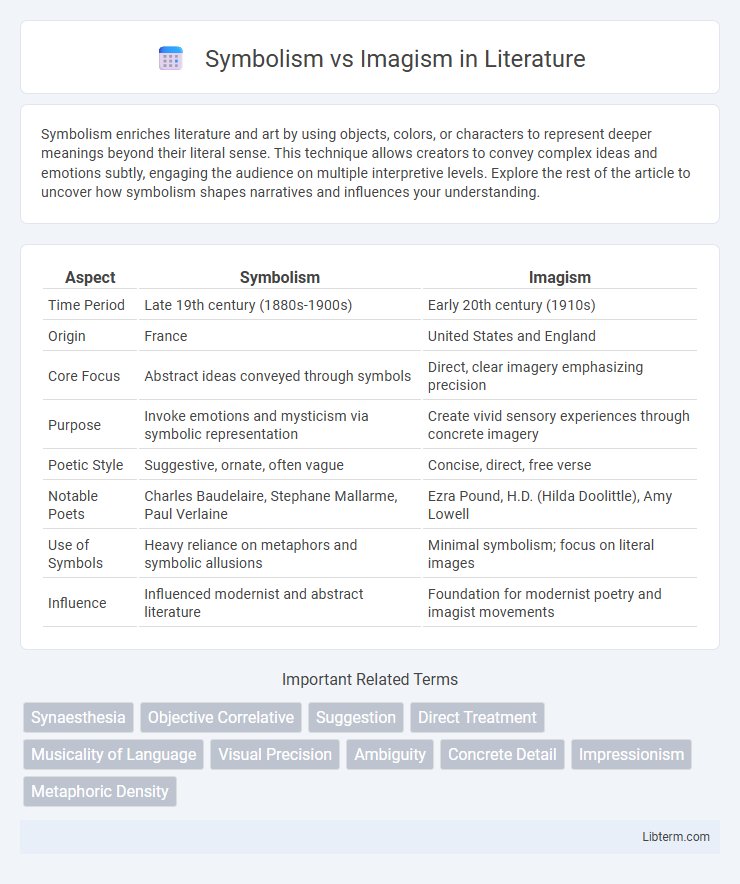Symbolism enriches literature and art by using objects, colors, or characters to represent deeper meanings beyond their literal sense. This technique allows creators to convey complex ideas and emotions subtly, engaging the audience on multiple interpretive levels. Explore the rest of the article to uncover how symbolism shapes narratives and influences your understanding.
Table of Comparison
| Aspect | Symbolism | Imagism |
|---|---|---|
| Time Period | Late 19th century (1880s-1900s) | Early 20th century (1910s) |
| Origin | France | United States and England |
| Core Focus | Abstract ideas conveyed through symbols | Direct, clear imagery emphasizing precision |
| Purpose | Invoke emotions and mysticism via symbolic representation | Create vivid sensory experiences through concrete imagery |
| Poetic Style | Suggestive, ornate, often vague | Concise, direct, free verse |
| Notable Poets | Charles Baudelaire, Stephane Mallarme, Paul Verlaine | Ezra Pound, H.D. (Hilda Doolittle), Amy Lowell |
| Use of Symbols | Heavy reliance on metaphors and symbolic allusions | Minimal symbolism; focus on literal images |
| Influence | Influenced modernist and abstract literature | Foundation for modernist poetry and imagist movements |
Understanding Symbolism: An Overview
Symbolism emphasizes the use of symbols to convey deeper meanings, emotions, and ideas beyond literal interpretation, often relying on metaphorical and suggestive imagery. It emerged in the late 19th century as a reaction against realism, aiming to express the ineffable and spiritual aspects of human experience. Key Symbolist poets such as Charles Baudelaire and Stephane Mallarme utilized symbolic language to evoke moods and abstract concepts rather than straightforward descriptions.
Imagism Defined: Core Principles
Imagism is a literary movement emphasizing clarity, precision, and economy of language to evoke vivid sensory images. Core principles include direct treatment of the "thing" whether subjective or objective, use of exact words instead of vague or decorative language, and creating a rhythm that corresponds to the expression of the image. Prominent Imagist poets like Ezra Pound and H.D. championed these ideals to break from traditional poetic forms and promote a modernist focus on visual and emotional immediacy.
Historical Origins of Symbolism and Imagism
Symbolism emerged in the late 19th century as a reaction against realism, rooted in French literature and visual arts, emphasizing metaphor and the expression of absolute truths through symbols. Imagism developed in the early 20th century, primarily in Anglo-American poetry, as a response to late Symbolist abstraction, advocating for precise, clear images and economy of language influenced by Japanese haiku and classical Greek poetry. The historical divergence reflects Symbolism's focus on mysticism and emotion, while Imagism pursues concrete imagery and direct presentation.
Key Figures in Symbolism
Key figures in Symbolism include Charles Baudelaire, whose works pioneered the movement's focus on mood and metaphor, and Stephane Mallarme, known for his complex and allusive poetry that emphasized suggestion over direct statement. Arthur Rimbaud introduced vivid, dreamlike imagery that influenced later Symbolists, while Paul Verlaine's exploration of musicality in verse helped shape the movement's emphasis on emotion and nuance. These poets collectively challenged realism, opting for symbolic representation to evoke deeper truths and emotional resonance.
Major Poets of the Imagist Movement
Major poets of the Imagist movement include Ezra Pound, H.D. (Hilda Doolittle), and Amy Lowell, who emphasized clarity, precision, and economy of language in their poetry. Imagism rejected the ornate and often vague symbolism of Symbolist poets like Stephane Mallarme and Charles Baudelaire, instead aiming to present clear, sharp images directly to the reader's mind. Pound's poem "In a Station of the Metro" exemplifies Imagism's focus on vivid sensory experience and concise expression.
Symbolist Techniques and Devices
Symbolist techniques center on the use of metaphor, allegory, and suggestion to evoke emotions and ideas indirectly, often emphasizing the spiritual or mystical realm. Symbolist poets employ symbols that carry multiple layers of meaning, relying on synesthetic imagery and musicality in language to provoke personal interpretation. This approach contrasts with Imagism's emphasis on clarity and precision, as Symbolism favors ambiguity and the evocation of mood over direct description.
Imagist Style: Precision and Clarity
Imagist style emphasizes precision and clarity by using clear, sharp images and concise language to evoke sensory experiences directly. Unlike Symbolism, which relies on abstract symbols and emotional resonance, Imagism prioritizes exactness and straightforward depiction to capture the essence of the subject. This approach creates vivid, concrete imagery that engages readers through immediate visual impact and economy of words.
Symbolism vs Imagism: Philosophical Differences
Symbolism emphasizes expressing ideas and emotions through symbolic representations, often abstract and suggestive, while Imagism prioritizes clarity, precision, and direct presentation of visual images. Symbolism seeks to evoke the ineffable and spiritual aspects of human experience, contrasting with Imagism's commitment to concrete, sensory detail and economy of language. Philosophically, Symbolism aligns with metaphysical exploration, whereas Imagism adheres to empirical observation and objective description.
Lasting Influence on Modern Poetry
Symbolism, emerging in the late 19th century, profoundly shaped modern poetry by emphasizing subjective experience and evocative imagery that conveys emotions beyond literal meanings. Imagism, developed in the early 20th century, promoted clarity, precision, and economy of language, influencing poets like Ezra Pound and H.D. to focus on vivid, direct images. The lasting influence of both movements is evident in contemporary poetry's balance between symbolic depth and crisp, image-driven expression.
Choosing Between Symbolism and Imagism in Creative Writing
Choosing between Symbolism and Imagism in creative writing depends on the desired depth of meaning and vividness of detail; Symbolism relies on metaphorical and often abstract representations to evoke complex emotions and ideas, while Imagism prioritizes clear, precise images to create immediate sensory impressions. Writers seeking to explore layered themes and philosophical concepts often favor Symbolism for its richness in allegory and suggestion, whereas those aiming for concise, sharp, and direct expression lean towards Imagism to engage readers through striking visual and sensory language. Balancing the two approaches can enhance narrative depth, combining Symbolism's interpretive resonance with Imagism's evocative clarity.
Symbolism Infographic

 libterm.com
libterm.com